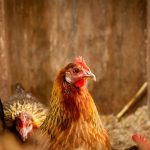Chickens are highly susceptible to heat stress, which can significantly impact their health and productivity. When temperatures rise, chickens may experience decreased feed intake, reduced egg production, and increased mortality rates. Heat stress can compromise their immune systems, making them more vulnerable to diseases and infections.
High temperatures can also lead to dehydration, heat exhaustion, and heat stroke in chickens, all of which can be life-threatening if not addressed promptly. Understanding the impact of heat on chickens is crucial for poultry farmers to implement effective strategies for mitigating its effects and ensuring the well-being of their flock. Heat stress in chickens manifests in various ways, including panting, wing spreading, reduced activity, and decreased egg quality.
Chickens may also exhibit signs of distress such as lethargy, loss of appetite, and increased water consumption. It is essential for farmers to recognize these signs and take appropriate action to prevent further heat-related complications. By understanding the impact of heat on chickens, farmers can make informed decisions about how to best care for their flock during periods of high temperatures, ultimately minimizing the negative effects of heat stress on their chickens.
Table of Contents
- 1 Providing Adequate Shade and Ventilation
- 2 Offering Cool Water and Hydration Solutions
- 3 Utilizing Cooling Devices and Techniques
- 4 Adjusting Feeding and Schedule
- 5 Monitoring and Managing Heat Stress
- 6 Implementing Emergency Plans for Extreme Heat Events
- 7 FAQs
- 7.1 What are the best ways to keep chickens cool in the Arizona heat?
- 7.2 How can I provide shade for my chickens in the Arizona heat?
- 7.3 What are some tips for ensuring proper ventilation in the chicken coop during the Arizona heat?
- 7.4 How often should I change the water for my chickens in the Arizona heat?
- 7.5 What are some frozen treats I can give to my chickens to help them stay cool in the Arizona heat?
Key Takeaways
- Heat stress can have a significant impact on chickens, affecting their health, egg production, and overall well-being.
- Providing adequate shade and ventilation is crucial in helping chickens regulate their body temperature and stay cool during hot weather.
- Offering cool water and hydration solutions, such as electrolytes, can help chickens stay hydrated and cope with heat stress.
- Utilizing cooling devices and techniques, such as misters or fans, can help lower the temperature in chicken coops and provide relief from heat.
- Adjusting feeding and schedule by offering lighter meals and feeding during cooler times of the day can help reduce heat stress in chickens.
- Monitoring and managing heat stress through regular observation and taking proactive measures can help prevent serious health issues in chickens.
- Implementing emergency plans for extreme heat events, such as relocating chickens to a cooler area or providing emergency cooling measures, is essential for ensuring their well-being during heatwaves.
Providing Adequate Shade and Ventilation
Shade: A Key Element in Reducing Heat Stress
One of the most effective ways to help chickens cope with heat stress is by providing adequate shade in their living environment. Shade can help reduce the direct impact of the sun’s rays on the chickens, lowering the overall temperature in their living space. This can be achieved by providing natural shade from trees or by constructing shelters or awnings to protect the chickens from direct sunlight.
Ventilation: Allowing Hot Air to Escape
Additionally, proper ventilation is essential for allowing hot air to escape from the chicken coop and for promoting air circulation, which can help lower the ambient temperature. This can be achieved through the use of windows, vents, and fans to facilitate airflow and prevent the buildup of heat inside the coop.
Coop Location: Minimizing Direct Sun Exposure
In addition to providing shade and ventilation, it is important to consider the location of the chicken coop. Placing the coop in a shaded area or positioning it in a way that minimizes direct exposure to the sun can help reduce the impact of high temperatures on the chickens.
By ensuring that the living environment of the chickens is well-shaded and properly ventilated, farmers can create a more comfortable and safe space for their flock to thrive in spite of the heat.
Offering Cool Water and Hydration Solutions
Proper hydration is essential for helping chickens cope with heat stress. During periods of high temperatures, chickens may experience increased water loss through panting and evaporation, making it crucial for them to have access to cool water at all times. Farmers should regularly check water sources to ensure that they are clean, cool, and free from contaminants.
Additionally, providing multiple water sources throughout the chicken coop can help ensure that all chickens have access to water, even in larger flocks where competition for water may be higher. In addition to offering cool water, farmers can also implement hydration solutions such as electrolyte supplements or vitamin-enriched water to help replenish essential nutrients lost through heat stress. These solutions can help support the overall health and well-being of the chickens during periods of high temperatures.
By prioritizing hydration and offering cool water and hydration solutions, farmers can help mitigate the negative effects of heat stress on their flock and promote their overall welfare.
Utilizing Cooling Devices and Techniques
In addition to providing shade and ventilation, farmers can utilize various cooling devices and techniques to help chickens cope with heat stress. One effective method is to use misters or sprinkler systems to create a fine spray of water that can help lower the ambient temperature in the chicken coop. This can provide relief for the chickens and help prevent heat-related complications.
Additionally, evaporative cooling pads or fans can be used to further lower the temperature inside the coop and promote a more comfortable living environment for the chickens. Another technique for cooling chickens is to provide them with access to shallow pools or baths of cool water. Chickens may wade or bathe in these pools to lower their body temperature and find relief from the heat.
Farmers should ensure that these pools are shallow enough to prevent drowning and that they are regularly cleaned and refilled with fresh water to maintain hygiene and safety for the chickens. By utilizing cooling devices and techniques, farmers can help create a more comfortable and hospitable environment for their flock during periods of high temperatures.
Adjusting Feeding and Schedule
During periods of heat stress, it may be necessary to adjust the feeding schedule and diet of chickens to help them cope with high temperatures. Chickens may experience reduced appetite during hot weather, so it is important to monitor their feed intake and adjust feeding times accordingly. Feeding chickens during the cooler parts of the day, such as early morning or late evening, can help encourage them to eat when they are more likely to have an appetite.
Additionally, farmers may consider adjusting the composition of the chicken feed during periods of high temperatures. Feeding a diet with a lower protein content can help reduce metabolic heat production in chickens, as protein digestion generates more metabolic heat compared to carbohydrates or fats. Providing a well-balanced diet that meets the nutritional needs of the chickens while taking into account the impact of heat stress can help support their overall health and well-being during hot weather.
Monitoring and Managing Heat Stress

Monitoring for Signs of Heat Stress
Farmers should monitor their chickens’ behavior, feed intake, water consumption, and overall condition to identify early signs of heat stress. This includes looking out for changes in behavior, such as lethargy or restlessness, as well as decreases in feed intake and water consumption.
Proactive Management Strategies
In addition to monitoring, managing heat stress involves taking proactive measures to prevent its onset. This includes implementing strategies such as providing shade, ventilation, cool water, hydration solutions, and utilizing cooling devices. By taking these steps, farmers can help reduce the risk of heat stress in their flock.
Minimizing the Impact of Heat Stress
By being proactive in managing heat stress, farmers can help minimize its impact on their chickens and promote their overall welfare during periods of high temperatures. This not only helps to reduce mortality rates but also improves the overall health and productivity of the flock.
Implementing Emergency Plans for Extreme Heat Events
In cases of extreme heat events, it is crucial for farmers to have emergency plans in place to ensure the safety and well-being of their flock. This may include having contingency measures for providing additional shade, ventilation, and cooling devices as well as ensuring access to an adequate supply of cool water and hydration solutions. Farmers should also be prepared to adjust feeding schedules and diets as needed to support their chickens during extreme heat events.
Furthermore, it is important for farmers to have protocols in place for identifying and addressing signs of heat-related illnesses or distress in their flock. This may involve seeking veterinary care or administering first aid as necessary. By having emergency plans in place for extreme heat events, farmers can be better prepared to respond effectively and protect their flock from the potentially life-threatening effects of severe heat stress.
In conclusion, understanding the impact of heat on chickens is essential for implementing effective strategies to mitigate its effects and ensure the well-being of the flock. By providing adequate shade and ventilation, offering cool water and hydration solutions, utilizing cooling devices and techniques, adjusting feeding schedules and diets, monitoring and managing heat stress, and implementing emergency plans for extreme heat events, farmers can help support their chickens during periods of high temperatures and promote their overall welfare. Prioritizing the health and comfort of chickens during hot weather is crucial for maintaining a productive and thriving flock.
If you’re looking for more information on keeping chickens cool in the Arizona heat, you might also be interested in learning about how to keep guinea fowl with chickens. This article from Poultry Wizard discusses whether guinea fowl can live with chickens and provides valuable insights into the dynamics of keeping different poultry species together. Check it out here.
FAQs
What are the best ways to keep chickens cool in the Arizona heat?
Some of the best ways to keep chickens cool in the Arizona heat include providing shade, proper ventilation, access to cool water, and frozen treats.
How can I provide shade for my chickens in the Arizona heat?
You can provide shade for your chickens by using tarps, umbrellas, or natural shade from trees or shrubs. It’s important to ensure that the shade is available throughout the day as the sun moves.
What are some tips for ensuring proper ventilation in the chicken coop during the Arizona heat?
To ensure proper ventilation in the chicken coop, you can use fans, open windows or vents, and elevated roosts to allow for air circulation. It’s important to avoid overcrowding in the coop to maintain good airflow.
How often should I change the water for my chickens in the Arizona heat?
In the Arizona heat, it’s important to change the water for your chickens at least twice a day to ensure that they have access to cool, fresh water. You can also add ice to the water to help keep it cool.
What are some frozen treats I can give to my chickens to help them stay cool in the Arizona heat?
You can give your chickens frozen fruits, vegetables, or even ice blocks with treats frozen inside to help them stay cool in the Arizona heat. This can also provide them with some entertainment and mental stimulation.
Meet Walter, the feathered-friend fanatic of Florida! Nestled in the sunshine state, Walter struts through life with his feathered companions, clucking his way to happiness. With a coop that’s fancier than a five-star hotel, he’s the Don Juan of the chicken world. When he’s not teaching his hens to do the cha-cha, you’ll find him in a heated debate with his prized rooster, Sir Clucks-a-Lot. Walter’s poultry passion is no yolk; he’s the sunny-side-up guy you never knew you needed in your flock of friends!







